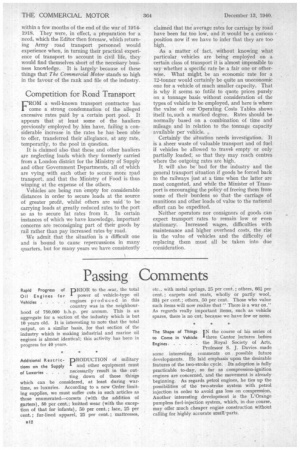Passing Comments
Page 18

Page 19

If you've noticed an error in this article please click here to report it so we can fix it.
Rapid Progress of pRIOR to the -war, the total Oil Engines for I power of vehicle-type oil Vehicles engines produced in this country was in the neighbourhood of 750,000 b.h.p. per annum. This is an aggregate for a section of, the industry which is but 10 years old. It is interesting to note that the total output, on a similar basis, for that section of the industry which is making industrial and marine oil engines is almost identical; this activity has been in progress for 40 years.
PRODUCTION of military and other equipment must necessarily result in the cutting down of those things which can be considered, at least during wartime, as luxuries. According to a new Order limiting supplies, we must suffer cuts in such articles as those enumerated—corsets (with the addition of garters), 50 per cent.; knitted wear (with the exception of that for infants), 50 per cent. ; lace, 25 per cent.; fur-lined apparel, 25 per cent. ; mattresses,
Additional Restrictions on the Supply of Luxuries . . . etc., with metal springs, 25 per cent. ; others, 6431 per cent. ; carpets and mats, wholly or partly wool, 33i per cent.; others, 50 per cent. Those who value such items will now realize that" There is a war on." As regards really important items, such as vehicle spares, there is no cut, because we have few or none.
I N the course of his series of three Cantor lectures before the Royal Society of Arts, Professor S. J. Davies made some interesting comments on possible future developments. He laid emphasis upon the desirable features of the two-stroke cycle. Its adoption is fully practicable to-day, so far as compression-ignition engines are concerned, and the movement is already beginning. As regards petrol engines, he ties up the possibilities of the two-stroke system with petrol injection in order to avoid gas loss on compression. Another interesting development is the L'Orange pumpless fuel-injection system, which, in due course, may offer much cheaper engine construction without calling for highly accurate small-parts. The Shape of Things to Come in Vehicle
Engines
Considerable Economy URING one of his R.S.A.
Obtained by Oil A-01 lectures, Professor Davies
Filtration referred to figures given by Mr. T. C. Worth in a recent paper read before the Institution of Automobile Engineers; 68 per cent, of the operators of 33,198 vehicles declared that money was salted by lubricating-oil filtration, the average saving being 36.3 per cent. Those who use filters find that the vehicle will run 4,823 miles between oil changes, whereas those who do not use such appliances average 1,405 Miles on one sump content. In these days the importance of oil conservation is so obvious that these figures point a most important moral.
THOSE who are in the for . tunate position of being able to utilize the light alloys
of aluminium and magnesium will be particularly appreciative of the new Birrnal pocket charts, issued by the Birmingham Aluminium Casting (1903) Co., Ltd., Birrnid Works, Smethwick, Birmingham. There are three of these, the first dealing with aluminium and zinc alloys, their mechanical and physical properties; the second treating with aluminium and Elektron alloys, their mechanical and physical properties and applications; whilst the third covers the composition and heat treatment of the latter alloys.
ar Useful. Data for Technicians Employing
Light Alloys . .




























































